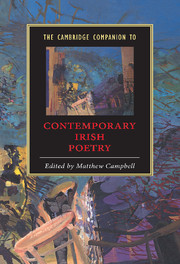Book contents
- Frontmatter
- 1 Ireland in poetry
- 2 From Irish mode to modernisation
- 3 Patrick Kavanagh and antipastoral
- 4 Louis MacNeice
- 5 The Irish modernists and their legacy
- 6 Poetry of the 1960s
- 7 Violence in Seamus Heaney's poetry
- 8 Mahon and Longley
- 9 Between two languages
- 10 Boland, McGuckian, Ni Chuilleanain and the body of the nation
- 11 Sonnets, centos and long lines
- 12 Performance and dissent
- 13 Irish poets and the world
- 14 Irish poetry into the twenty-first century
- Further reading
- Index
- Series List
9 - Between two languages
poetry in Irish, English and Irish English
Published online by Cambridge University Press: 28 May 2006
- Frontmatter
- 1 Ireland in poetry
- 2 From Irish mode to modernisation
- 3 Patrick Kavanagh and antipastoral
- 4 Louis MacNeice
- 5 The Irish modernists and their legacy
- 6 Poetry of the 1960s
- 7 Violence in Seamus Heaney's poetry
- 8 Mahon and Longley
- 9 Between two languages
- 10 Boland, McGuckian, Ni Chuilleanain and the body of the nation
- 11 Sonnets, centos and long lines
- 12 Performance and dissent
- 13 Irish poets and the world
- 14 Irish poetry into the twenty-first century
- Further reading
- Index
- Series List
Summary
ʿDo you hear me whispering to you across the Golden Vale?
Do you hear me bawling to you across the hearthrug?ʾ
(Paul Durcan, ʿIreland 1977ʾ)Introduction: the position of Irish in contemporary Irish poetry
Irish literature has historically possessed what Thomas Kinsella calls a 'dual tradition', and continues to be written in the country's majority and minority languages, English and Irish, respectively. As the two languages keep up what Kinsella terms their 'dynamic interaction', many Irish readers have increasingly turned at least one of their two ears to Irish language literature, in the original, in translation, and via critiques that take into account both languages for a more comprehensive representation and understanding of Ireland's art and eras. Therefore, whereas in some quarters a narrow, monoglot view of Ireland's poetry still exists, recent critical studies of contemporary work recognise the need to account for the polyphony of voices which make up what Sean O Riordain called the 'fuaim na habhann' / riversound of the living stream of Irish writing.
- Type
- Chapter
- Information
- The Cambridge Companion to Contemporary Irish Poetry , pp. 149 - 168Publisher: Cambridge University PressPrint publication year: 2003
- 2
- Cited by



